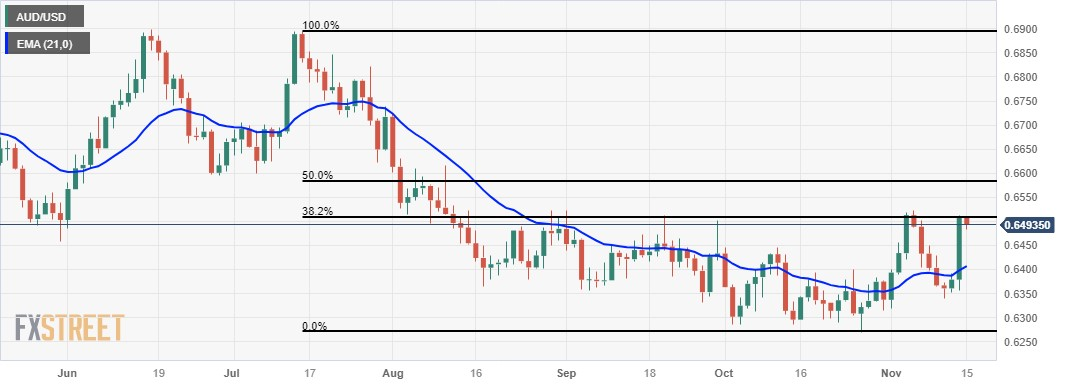- Australian Dollar maintains its position around the 0.6500 psychological level.
- Australia’s Wage Price Index (Q3) rose by 1.3% as expected and 4.0% annually.
- US Dollar faces pressure as US inflation slowed more than anticipated.
- China's Industrial Production exhibited growth at 4.6%; Retail Sales experienced an uptick, reaching 7.6%.
The Australian Dollar (AUD) hovers around the psychological level of 0.6500 on Wednesday. Tuesday's US CPI data unveiled a more pronounced deceleration in US inflation than initially predicted, leading to a substantial decline in the US Dollar (USD). Consequently, the AUD/USD pair saw a notable increase.
Australia’s Wage Price Index came in on Wednesday, revealing that quarterly labor cost inflation grew 1.3% as expected compared to the previous reading of 0.8%. The year-over-year data showed an increase of 4.0% more than the anticipated 3.9%. The Australian jobs data will be published on Thursday, providing further insights.
Australia's Westpac Consumer Confidence report indicated a significant drop in consumer sentiment for November. The increasing pressure on data-guided policy adjustments will likely pose a challenge for the Reserve Bank of Australia's (RBI) board.
China's Industrial Production (YoY) showed growth at 4.6% in October, a slight increase from the previous 4.5%, contrary to expectations of consistency. Retail Sales year-over-year saw an uptick to 7.6%, surpassing the anticipated 7.0%. These positive indicators in economic activities could offer support for the Australian Dollar (AUD).
The Dollar Index (DXY) recorded a 1.50% decline in the previous session, hitting its lowest point since early September. The Greenback faced additional pressure from increased risk appetite and a downward trend in US Treasury bonds. The US 10-year yield experienced a significant drop to an eight-week low at 4.43%.
The upcoming release of the US Producer Price Index and Retail Sales data later in the North American session has the potential to significantly influence the market. If these figures align with expectations, it might add further pressure on the Greenback.
Daily Digest Market Movers: Australian Dollar remains below a psychological level amid RBA’s uncertainty over policy rates
- Australia’s Westpac Consumer Confidence declined by 2.6% in November, swinging from the previous growth of 2.9%.
- RBA Assistant Governor (Economic) Marion Kohler stated that the decline in inflation is expected to be slower than initially anticipated. This is attributed to the persistent high level of domestic demand and robust pressures from labor and other costs. Kohler emphasized the need for a tighter policy to address the challenges posed by elevated inflation.
- RBA highlighted the challenges stemming from persistent inflationary pressures and a sluggish domestic economy in its Monetary Policy Statement (MPS) last Friday.
- RBA board acknowledges the financial struggles of many households. Budgets are indeed feeling the squeeze. In a twist of economic dynamics, the central bank painted a mixed picture by raising its inflation and GDP growth forecasts.
- RBA increased the Official Cash Rate (OCR) from 4.10% to a 12-year high of 4.35%, responding to the latest Monthly Consumer Price Index (YoY) for September, which indicated a notable increase of 5.6% compared to the expected 5.4% growth.
- Australia’s TD Securities Inflation (YoY) eased at 5.1% in September from 5.7% prior.
- Economists at the National Australia Bank (NAB) anticipate another 25 basis points hike in February following the Q4 inflation data. Additionally, NAB believes rate cuts will unlikely commence until November 2024.
- The US-Sino Presidential meeting is on the horizon, and US President Joe Biden aims to rebuild military-to-military connections with China. The much-anticipated face-to-face between Biden and Chinese President Xi Jinping is scheduled for Wednesday during the Asia-Pacific Economic Cooperation summit in San Francisco., marking their first in-person meeting in a year.
- The US Consumer Price Index (CPI) for October showed lower readings than expected, with the annual rate slowing from 3.7% to 3.2%, falling below the consensus forecast of 3.3%. The monthly CPI reduced to 0.0% from 0.4%.
- The US Core CPI rose by 0.2% below the expectations of 0.3%, and the annual rate decreased to 4.0% from 4.1% prior.
- US Monthly Budget Statement reported a deficit of $67B in October, compared to the expected deficit of $65B.
Technical Analysis: Australian Dollar hovers near the 0.6500 major level backed by the 38.2% Fibonacci retracement
The Australian Dollar trades around 0.6490 on Wednesday aligned to the immediate resistance at 0.6500 psychological level, followed by the 38.2% Fibonacci retracement at 0.6508. The 50% retracement is the next upside target at the 0.6582 level. On the downside, the AUD/USD pair could meet the support at the 21-day Exponential Moving Average (EMA) lined up with the major level at 0.6400.
AUD/USD: Daily Chart
Australian Dollar price today
The table below shows the percentage change of Australian Dollar (AUD) against listed major currencies today. Australian Dollar was the weakest against the .
| USD | EUR | GBP | CAD | AUD | JPY | NZD | CHF | |
| USD | 0.04% | 0.02% | -0.10% | -0.08% | 0.11% | -0.36% | -0.06% | |
| EUR | -0.05% | -0.02% | -0.14% | -0.13% | 0.07% | -0.40% | -0.11% | |
| GBP | -0.04% | 0.01% | -0.14% | -0.14% | 0.09% | -0.38% | -0.07% | |
| CAD | 0.10% | 0.16% | 0.16% | 0.05% | 0.24% | -0.25% | 0.08% | |
| AUD | 0.09% | 0.13% | 0.12% | -0.02% | 0.21% | -0.27% | 0.05% | |
| JPY | -0.12% | -0.09% | -0.11% | -0.23% | -0.21% | -0.46% | -0.15% | |
| NZD | 0.35% | 0.39% | 0.38% | 0.26% | 0.27% | 0.48% | 0.32% | |
| CHF | 0.02% | 0.06% | 0.04% | -0.08% | -0.06% | 0.14% | -0.34% |
The heat map shows percentage changes of major currencies against each other. The base currency is picked from the left column, while the quote currency is picked from the top row. For example, if you pick the Euro from the left column and move along the horizontal line to the Japanese Yen, the percentage change displayed in the box will represent EUR (base)/JPY (quote).
Economic Indicator
Australia Employment Change s.a.
The Employment Change released by the Australian Bureau of Statistics is a measure of the change in the number of employed people in Australia. The statistic is adjusted to remove the influence of seasonal trends. Generally speaking, a rise in Employment Change has positive implications for consumer spending, stimulates economic growth, and is bullish for the Australian Dollar (AUD). A low reading, on the other hand, is seen as bearish.
Read more.
Information on these pages contains forward-looking statements that involve risks and uncertainties. Markets and instruments profiled on this page are for informational purposes only and should not in any way come across as a recommendation to buy or sell in these assets. You should do your own thorough research before making any investment decisions. FXStreet does not in any way guarantee that this information is free from mistakes, errors, or material misstatements. It also does not guarantee that this information is of a timely nature. Investing in Open Markets involves a great deal of risk, including the loss of all or a portion of your investment, as well as emotional distress. All risks, losses and costs associated with investing, including total loss of principal, are your responsibility. The views and opinions expressed in this article are those of the authors and do not necessarily reflect the official policy or position of FXStreet nor its advertisers. The author will not be held responsible for information that is found at the end of links posted on this page.
If not otherwise explicitly mentioned in the body of the article, at the time of writing, the author has no position in any stock mentioned in this article and no business relationship with any company mentioned. The author has not received compensation for writing this article, other than from FXStreet.
FXStreet and the author do not provide personalized recommendations. The author makes no representations as to the accuracy, completeness, or suitability of this information. FXStreet and the author will not be liable for any errors, omissions or any losses, injuries or damages arising from this information and its display or use. Errors and omissions excepted.
The author and FXStreet are not registered investment advisors and nothing in this article is intended to be investment advice.
Recommended content
Editors’ Picks

EUR/USD turns positive to retake 1.0500, as focus shifts to Fed Minutes
EUR/USD is trading close to 1.0500 in Tuesday's European trading, erasing lsses to trade in the green. The US Dollar reverses President-elect Trump’s tariff threats-led gains, allowing the pair to stage a modest recovery heading into the release of the Fed Minutes later in the day.

GBP/USD extends recovery toward 1.2600 ahead of BoE's Pill, Fed Minutes
GBP/USD extends the recovery toward 1.2600 in the European session on Tuesday, following a slump to the 1.2500 area in Asian trading. The pair finds footing amid a retreat in the US Dollar as markets look past Trump tariff threats, bracing for BoE Pill's speech and Fed Minutes.

Gold price defends $2,600 ahead of FOMC minutes; not out of the woods yet
Gold price retains its negative bias for the second straight day and trades just above a one-week low during the first half of the European session on Tuesday. The growing conviction that Donald Trump's expansionary policies will reignite inflation and limit the scope for the Fed to cut interest rates further triggers a fresh leg up in the US Treasury bond yields.

Trump shakes up markets again with “day one” tariff threats against CA, MX, CN
Pres-elect Trump reprised the ability from his first term to change the course of markets with a single post – this time from his Truth Social network; Threatening 25% tariffs "on Day One" against Mexico and Canada, and an additional 10% against China.

Eurozone PMI sounds the alarm about growth once more
The composite PMI dropped from 50 to 48.1, once more stressing growth concerns for the eurozone. Hard data has actually come in better than expected recently – so ahead of the December meeting, the ECB has to figure out whether this is the PMI crying wolf or whether it should take this signal seriously. We think it’s the latter.

Best Forex Brokers with Low Spreads
VERIFIED Low spreads are crucial for reducing trading costs. Explore top Forex brokers offering competitive spreads and high leverage. Compare options for EUR/USD, GBP/USD, USD/JPY, and Gold.
